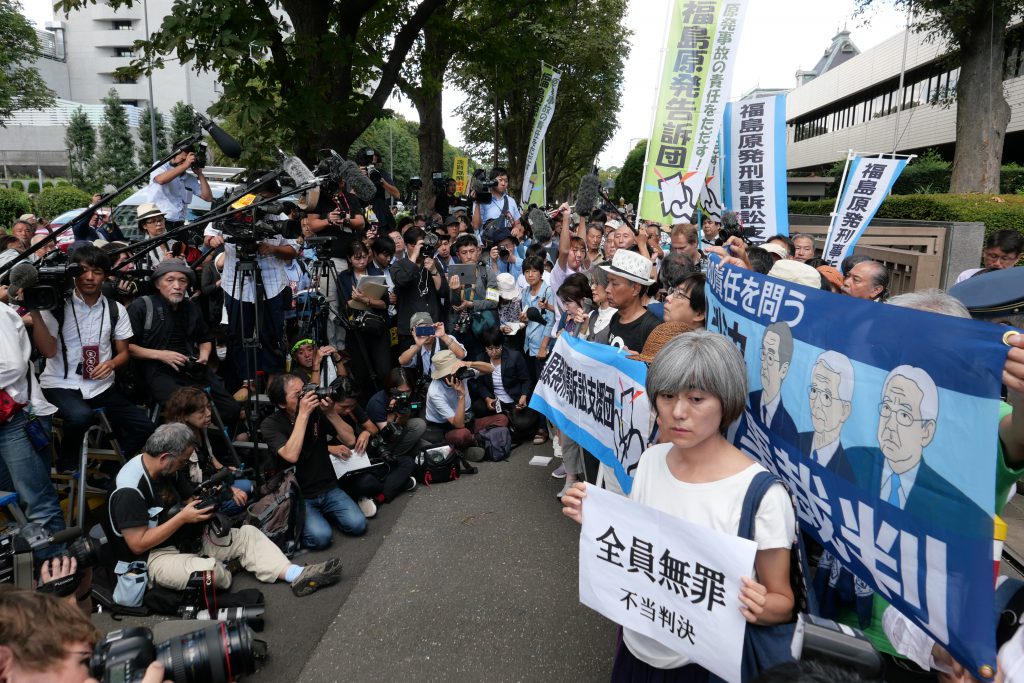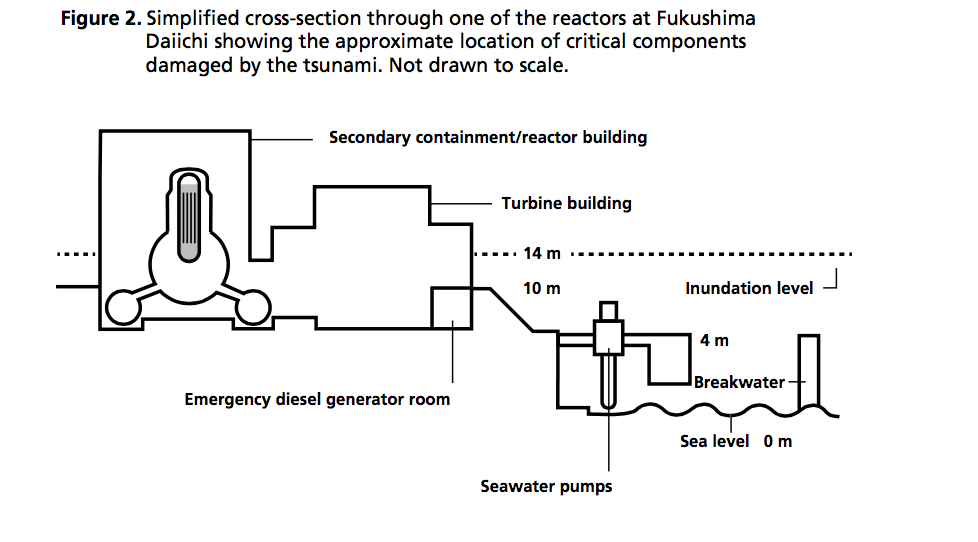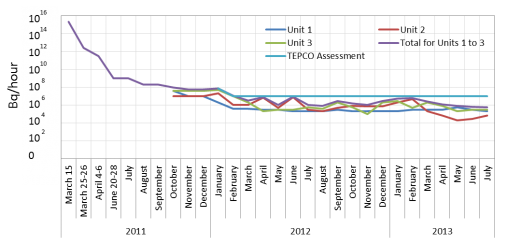TEPCO Criminal Trial: Defendants Acquitted
– Court Went Completely Out of its Way to Rescue TEPCO Executives
by Kaido Yuichi (attorney representing injured parties in TEPCO criminal trial)

Failure to acknowledge damage done and debasement of safety
In its September 19 ruling in the trial to examine the criminal liability of former TEPCO executives Katsumata Tsunehisa, Takekuro Ichiro and Muto Sakae. Tokyo District Court, Fourth Criminal Division (Judge Nagafuchi Ken’ichi) acquitted all three defendants.
TEPCO’s civil engineering group had advised the defendants during their tenure as executives that based on a long-term assessment by the Headquarters for Earthquake Research Promotion (a government agency, abbreviated as “Suihon”), it would be advisable to take tsunami countermeasures at the Fukushima nuclear power plants (NPPs). Concerned, however, about the large final costs of such construction and the possibility that undertaking construction of large-scale tsunami countermeasures would motivate the local municipalities to ask them to shut down the reactors, the executives deferred these countermeasures, falling further behind schedule as time went on. Then, to impede discovery of the issue, they concealed the tsunami calculation figures, informing neither the national nor prefectural governments nor relevant specialists about them, subsequently plotting for behind-the-scenes negotiations with the national government, municipalities, specialists and other companies.
And then, the Great East Japan Earthquake came along, and the Fukushima Daiichi NPP was hit by a tsunami about 15 meters high, which was approximately what had been predicted. If they had implemented the countermeasures their subordinates had suggested, it is believed they could have prevented the accident from occurring. The focus of this trial was to see whether these executives, who had quashed their subordinates’ suggestions, could be found criminally negligent.
This ruling has many problematic points. Two of the most serious problems are that it does not address the damage from the accident or the tragic situation at Futaba Hospital, and that it denies the standards set by the Supreme Court’s ruling on the Ikata NPP, which called for a high degree of safety at NPPs to prevent even the remote possibility of an accident because the statutory regulations and state of Japan’s standards for screening at that time were not based on the premise of ensuring absolute safety.
Failure to consider measures to avoid accidents other than suspending operations
The biggest problem must be twisting of opinions of the designated attorneys, and excluding from consideration any measures to avoid accidents aside from shutting down the reactors. The designated attorneys said that tsunami countermeasures which should have been taken, based on the long-term assessment by Suihon, included constructing seawalls, making entranceways for bringing in large objects and rooms containing major equipment watertight, and establishing alternative power sources on high ground. They also said the nuclear reactors should have been shut down until these steps had been taken. Despite this, the ruling offhandedly denied the validity of countermeasures other than suspending operations. It judged only whether suspending operations was necessary, and gave no consideration at all to whether other countermeasures were possible and whether through them the outcome could have been avoided, nor were these countermeasures considered in the judgment.
This was a bewildering judgement, because those were the biggest points in question in this trial. To establish evidence for the points at issue, the designated attorneys painstakingly demonstrated what had occurred in an analogous case in which measures had actually been taken at the Tokai Daini NPP, starting with consideration of tsunami countermeasures at roughly the same time as TEPCO, showing at what speed what sorts of measures had been implemented, such as making facilities watertight and putting in embankments in place of seawalls. They also presented evidence showing that it would have been possible to carry out seawall construction and that these countermeasures would have been completed by the time of the earthquake. The defendants and defense team claimed that even if they had built the seawalls, it would have required building comb-tooth-type seawalls in three places on the grounds: the south and north sides and center point, and that this kind of countermeasure would not have been able to hold back the tsunami that rolled up onto the grounds when it approached from all along the east side soon after the actual earthquake. They developed their counterargument on the premise that this measure would have been completed in time.
Denial of “Imperial Council” agreement on a tsunami countermeasure policy
Yamashita Kazuhiko, who headed the Chuetsu-Oki Earthquake Countermeasures Center and was number two in the Nuclear Power Division at TEPCO’s headquarters at that time, explained policies for implementing tsunami countermeasures based on Suihon’s long-term assessment to the defendants at a so-called “Imperial Council” (TEPCO’s top-down authoritative style of meetings) on February 16, 2008. Yamashita stated that those policies had been agreed on by the defendants. He went as far as to say that if the tsunami’s assumed height were 10 meters or less based on Suihon’s assessment, TEPCO should have had the tsunami countermeasure construction work completed by the time of the original back-check final report in 2009.

For health reasons, Yamashita was unable to testify in court, but continued to provide this kind of testimony through several sessions at his home during the inquiry stage. It was not testimony given under conditions of detention, but was recognized as being highly reliable. The ruling, however, denied the reliability of Yamashita’s testimony, and the judgement was clearly erroneous. Based on what had been discussed at the “Imperial Council,” a meeting of a cross section of the company’s groups was held on March 7, and even in the e-mail setting up the meeting and in the proceedings memo after the meeting, the policy for taking measures against tsunamis was considered to have been previously reported at a president’s meeting (i.e., “Imperial Council”). The records of that meeting show that a schedule had even been drawn up for construction of tsunami countermeasures on the 4-meter platform, where the seawater intake buildings were located. In the media at the time of the quake-proofing back-check interim report for the Fukushima Daiichi NPP at the end of March and in a Q & A list prepared for handling queries from Fukushima Prefecture, incorporation of the long-term assessment in the tsunami countermeasures and establishment of countermeasures on the 4-meter platform were clearly indicated. The ruling held that if the company’s policy had been agreed upon in February, there would have been no need to go there and explain it once again to Muto in June. Around February or March, however, the assumed tsunami height was settled at 10 meters or less, so it was deemed that the countermeasures on the 4-meter platform had been completed. Ultimately, however, the assumed height was determined to be 15.7 meters, able to top by a large margin the platform 10 meters above sea level, where the reactors and emergency generators were located, making the scale of the needed construction quite major. How to implement the countermeasures on the 10-meter platform became the theme of the June meeting, so there are no inconsistencies between the report to Muto and Yamashita’s survey report.
Denial of Long-term Assessment reliability
As noted above, in regards to Suihon’s long-term assessment, the ruling is erroneous in how it frames the question of whether the accident could have been avoided. The ruling assumes that the only reliable way to avoid the accident was to shut down the reactors. The ruling recognized that Suihon provides the official opinion that serves as the basis for Japan’s earthquake disaster countermeasures, but citing matters such as the differences of opinions expressed among experts, the Central Disaster Prevention Council’s exclusion of these different opinions from the targets for disaster prevention countermeasures, and the tsunami assessments by Fukushima and Ibaraki prefectures, it concluded that there was a lack of reliability for all measures except shutting down the reactors immediately.
However, a number of people including Long-term Assessment Subcommittee Chairman Shimazaki Kunihiko, committee member and historical earthquake and tsunami expert Tsuji Yoshinobu, and Maeda Kenji of the Suihon Secretariat had several discussions about other countermeasures in Suihon’s long-term assessment, compiling their unanimous views, so that the result had high reliability. Not even Matsuzawa Toru of the defense team objected to the long-term assessment’s conclusions. Also, Abe Katsuyuki, a seismologist who had been a core member of the national government’s safety inspection team, produced a survey report for the prosecutor that called for inclusion of the long-term assessment. Takahashi Tomoyuki is on record in a memo as strongly opposing TEPCO’s policy of delaying countermeasures. The ruling is extremely brazen in its denial of the reliability of the long-term assessment.
The ruling acknowledged that TEPCO’s civil engineering group was aware that if it had not incorporated Suihon’s long-term assessment, it would not have passed the government’s earthquake-proofing back-checks. These earthquake-proofing back-checks were initiated in 2006 and the work was scheduled to be completed within three years, by the final report. In TEPCO’s case, the company rapidly fell behind schedule, and by the time of the accident in 2011, the work had been postponed until 2016.
The ruling is recognized only as abstract, but Japan Atomic Power Co. (JAPC) executives and persons in charge have implemented Suihon’s tsunami countermeasures (for tsunamis with wave sources offshore from the Boso Peninsula, spreading to the ocean off the coast of Ibaraki). When they heard that TEPCO had abandoned its countermeasures, these executives expressed doubts that it was really acceptable for them to postpone such countermeasures. Regarding the reasons for abandoning the countermeasures, TEPCO’s General Manager Sakai Toshiaki of the Construction Engineering Center was compelled to explain to JAPC that “Kashiwazaki was shut down, but if we also shut Fukushima down for this, we don’t know how we would manage.” TEPCO did not report to the government that the assumed tsunami height it adopted when it incorporated Suihon’s long-term assessment had been 15.7 meters until four days before the earthquake disaster. It is truly appalling that TEPCO, who concealed this information, has been found blameless because the government didn’t tell them to shut down their nuclear reactors.
I was not expecting such a terrible ruling as this, which constitutes a major blot on judicial history. To avoid repeating nuclear accidents, this ruling must not be allowed to stand. The designated attorneys have filed an appeal, and we hope for a High Court ruling that serves justice.


